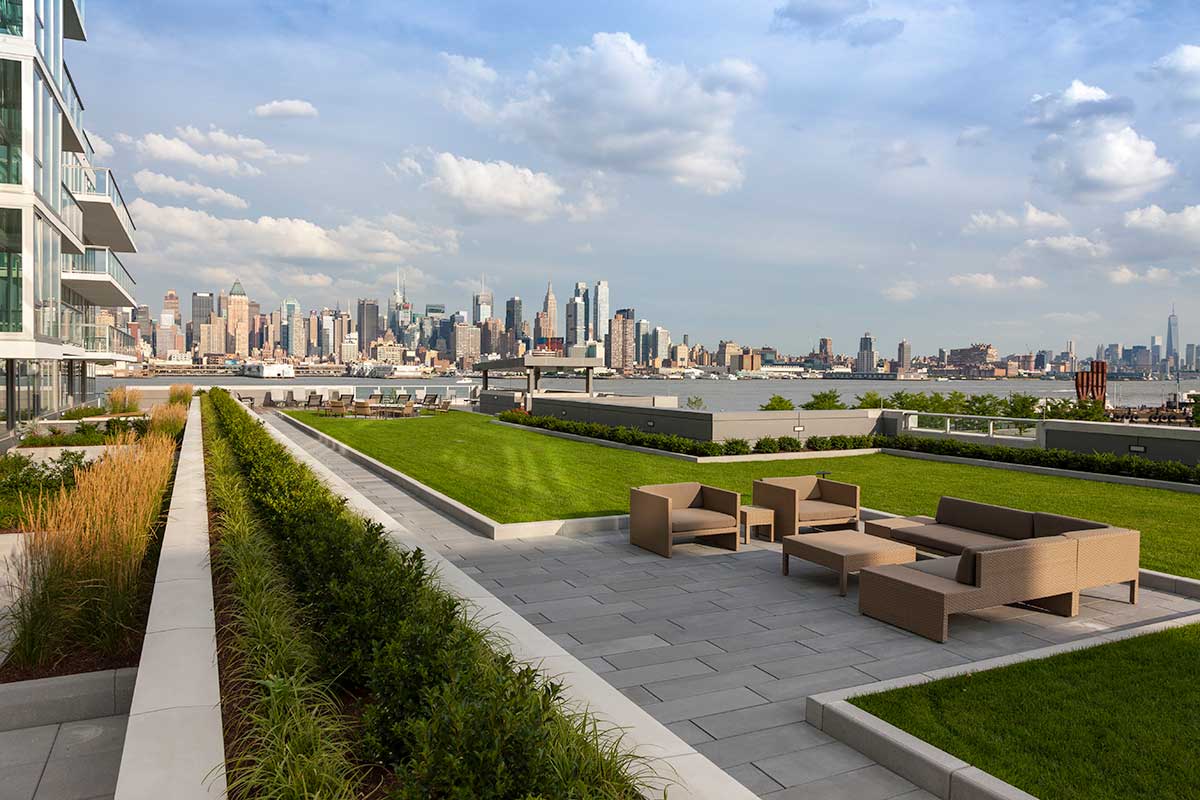Rooftop gardening enhances urban biodiversity and offers effective insulation for buildings. It contributes to cleaner air by absorbing pollutants and carbon dioxide.
Imagine transforming unused rooftops into green oases amidst concrete jungles; rooftop gardens are verdant retreats that provide numerous ecological, social, and economic benefits. Serving as miniature ecosystems, they not only reduce the urban heat island effect but also improve stormwater management by absorbing rainwater.
Rooftop Gardening Benefits: These elevated gardens extend the lifespan of roofing materials by protecting them from harsh weather while simultaneously reducing energy costs by providing natural cooling. By supporting pollinators and creating habitats, rooftop gardens bolster urban wildlife. For city dwellers, these spaces not only offer a touch of nature but also reduce noise pollution, creating peaceful enclaves above the hustle and bustle. Engaging in rooftop gardening can lead to increased community interaction and provide opportunities for local food production, further adding to its sustainability credentials.
Table of Contents
Elevated Environments: A Green Paradise
Rooftop gardening brings life to urban dwellings. Spaces usually empty, now boast lush greenery. These gardens improve air quality by filtering pollutants. They also act as natural insulators.
Residents enjoy lowered energy bills because these gardens reduce heat transfer. This eases urban heat islands, making cities cooler. Wildlife benefits from new habitats.
Rainwater is managed better with rooftop gardens. They help with water retention and drainage. This cuts down runoff issues in cities.
Such gardens create community spaces for people to gather, fostering social ties. Overall, rooftop gardens are a smart move towards sustainable living.

Credit: vkbkitchenandbath.com
The Air We Breathe: Purification Above
Rooftop gardens act as natural air purifiers. They absorb harmful pollutants, like ozone, from the air. This leads to better air quality for everyone.
These gardens improve our breathing. Plants absorb carbon dioxide and release oxygen. The air around us becomes fresher and cleaner.
With every rooftop garden added to a building, urban air purity improves. This helps us all breathe easier in the city.
Harvesting Rain: A Sustainable Approach
Rooftop gardens maximize rainwater use. They catch rain, reducing the need for tap water. These gardens help cut water bills. Plus, they minimize the risk of flooding. With rooftop gardens, cities see a drop in stormwater runoff. This limits sewage system overflow risks. The stored rainwater is later used. Garden watering and building cleaning benefit. Rainwater is free and plant-friendly. It has fewer chemicals compared to tap water. This makes it good for plants.
Rooftop gardens have layers that filter rain. They remove pollutants from water. By doing so, they protect local waterways from contamination. This method of reuse and reduced runoff is aligned with eco-friendly practices. It supports cities in becoming more sustainable. The practice contributes to a healthier urban environment.
Tackling Urban Heat: A Cooler Cityscape
Rooftop gardens combat the Urban Heat Island effect, making cities cooler. Plants absorb sunlight, rather than reflecting it back into the environment. This reduces overall city temperatures. These green spaces provide much-needed shade to buildings. The shade lowers cooling costs and cuts energy use.
Green rooftops also improve air quality by taking in carbon dioxide and releasing oxygen. They attract diverse wildlife, increasing urban biodiversity. All this leads to a healthier city environment. Green roofs can hold rainwater, slowing down runoff. This helps prevent overwhelming sewer systems during heavy rain.
Eco-friendly Energy: Reduced Consumption
Rooftop gardens are a powerhouse in insulating buildings. They act as a natural barrier, keeping homes cool during summer and warm in winter. This means you use less energy for heating and air conditioning, saving on utility bills.
This renewable approach caps energy costs. And reduces greenhouse gas emissions. Subsequently, your carbon footprint shrinks, making a big impact for a healthier planet.
Cultivating Crops: Urban Agriculture’s Rise
Rooftop gardening elevates green spaces above the cityscape, allowing urban dwellers to grow their own produce. The concept of urban agriculture is gaining traction as cities become more populated. These gardens improve food access and help build resilience against food shortages. This practice supports local ecosystems and provides a habitat for urban wildlife.
For city inhabitants, rooftop gardens offer a sustainable way to engage in food production. They utilize otherwise unused spaces and can lead to healthier eating habits. By joining the rooftop gardening movement, you contribute to stronger food security and a balanced urban ecology.
Hush Above The Hustle: Noise Reduction
Rooftop gardens are not just eye-pleasers; they play a crucial role in sound insulation. A terrace flush with greenery absorbs urban noise, creating a peaceful refuge. The plants and soil act as a natural barrier, reducing the din of everyday city hustle. Life on high can be surprisingly quiet thanks to these lush landscapes.
In the heart of a noisy city, rooftop gardens provide a much-needed sanctuary. With each plant acting as a miniature echo dampener, the collective effect is significant. It’s a simple equation: more greens equals less noise. For city dwellers, this translates to stress reduction and increased quality of life.

Credit: gbdmagazine.com
Sanctuaries For Species: Biodiversity Boon
Rooftop gardens are like oases in concrete jungles. These green spaces boost local wildlife numbers and forge links between urban environments and nature. Each garden can support a range of plants, which in turn attract diverse insect populations. This is just the start; birds and small mammals are also drawn to these vibrant habitats, increasing urban biodiversity.
By integrating rooftop gardens, cities see a patchwork of ecosystems come to life. These sky-high havens help sustain various species. They preserve essential pollinators such as bees and butterflies, crucial for a healthy eco-system. Rooftop gardens effectively become stepping stones that connect isolated green spaces, enhancing ecological corridors. This fosters a more connected urban ecosystem, vital for species to thrive.
Green Upkeep: The Ease Of Maintenance
Maintaining a rooftop garden is surprisingly simple. With the right setup, plants can thrive with minimal intervention. Drip irrigation systems keep watering consistent and hands-free. Drought-resistant plants reduce the need for frequent watering. Furthermore, weeds have less room to grow, slashing the time spent on weeding.
As gardening innovations progress, self-watering containers and smart monitoring systems make caregiving even easier. Such tools help track moisture levels and plant health. Gardeners now have more time to enjoy the beauty of their green space, rather than laboring over it.

Credit: www.toddhaimanlandscapedesign.com
Community And Well-being: More Than Aesthetics
Rooftop gardens serve as vibrant social hubs, fostering community connections. These green spaces often turn into common grounds where neighbors meet, communicate, and bond over garden-based activities. The presence of lush foliage and blooming flowers creates an inviting atmosphere that naturally draws people together.
Green spaces on rooftops have a profound impact on mental health improvement. Interacting with nature has been shown to reduce stress and promote relaxation, making these gardens an essential escape for urban residents. The presence of plants can also enhance mood and encourage a feeling of happiness and peace.
Building Biomimicry: Learning From Nature
Rooftop gardens are a living proof of nature’s genius. This concept transforms barren spaces into lush green oases. These gardens serve as design inspiration, showcasing how buildings can coexist with nature. By embracing these natural elements, architects can create structures that reflect the ecosystem’s efficiency. Plants, water, and even soil systems can be integrated into modern architecture. This integration leads to energy savings and increased biodiversity in urban areas.
The benefits extend beyond aesthetics, including temperature regulation within buildings, diminished urban heat island effect, and improved air quality. Plants on rooftops can act as natural air filters, combat pollution, and produce oxygen. These green spaces are not just a retreat; they are a blueprint for sustainable living. By mimicking nature’s processes, rooftop gardens offer a forward-thinking approach to urban planning and architecture.
Legislation And Incentives: Encouraging Rooftop Greenery
Urban areas foster rooftop gardens for a greener environment. Local governments often create policies to support this urban greening. These policies promote the transformation of unused rooftops into vibrant green spaces.
Building owners receive financial incentives to encourage rooftop gardening. These may include tax reductions, rebates, or grants. The goal is to offset costs associated with initial setup and maintenance of these gardens.
The benefits extend beyond financial savings. Rooftop gardens contribute to reducing the urban heat island effect, improving air quality, and increasing biodiversity. They also manage stormwater runoff efficiently, leading to a sustainable urban environment.
Frequently Asked Questions For Rooftop Gardening Benefits
What Are The Advantages Of A Rooftop Garden?
Rooftop gardens reduce urban heat, enhance air quality, and save energy. They also provide insulation, create wildlife habitats, and manage stormwater.
How Do Rooftop Gardens Help Air Quality?
Rooftop gardens improve air quality by absorbing pollutants and carbon dioxide, thus purifying the surrounding air.
What Are 5 Benefits Of A Green Roof?
1. Green roofs improve air quality by absorbing pollutants. 2. They enhance building insulation, reducing energy costs. 3. They manage stormwater, reducing runoff and sewer overflow. 4. Green roofs increase urban biodiversity, supporting wildlife. 5. They mitigate the urban heat island effect, cooling cities.
How Do Rooftop Gardens Increase Biodiversity?
Rooftop gardens create habitats for varied plant species and wildlife, attracting birds, insects, and small mammals, thus enriching urban biodiversity.
Conclusion
Embracing rooftop gardening uplifts urban spaces with lush greenery while offering a suite of ecological and personal boons. These sky-high oases combat the urban heat island effect, enhance air quality, and foster serenity amidst concrete expanses. They optimize rainwater use and reduce noise pollution, creating a sustainable footprint in our crowded cities.
Envision your rooftop transformed into a verdant retreat that benefits both the planet and your well-being—a small step towards a greener future. Engage with rooftop gardening; it’s an investment in a healthier, more harmonious urban life.
